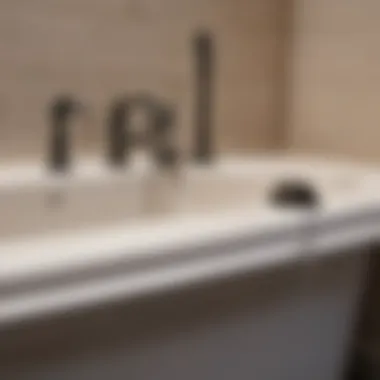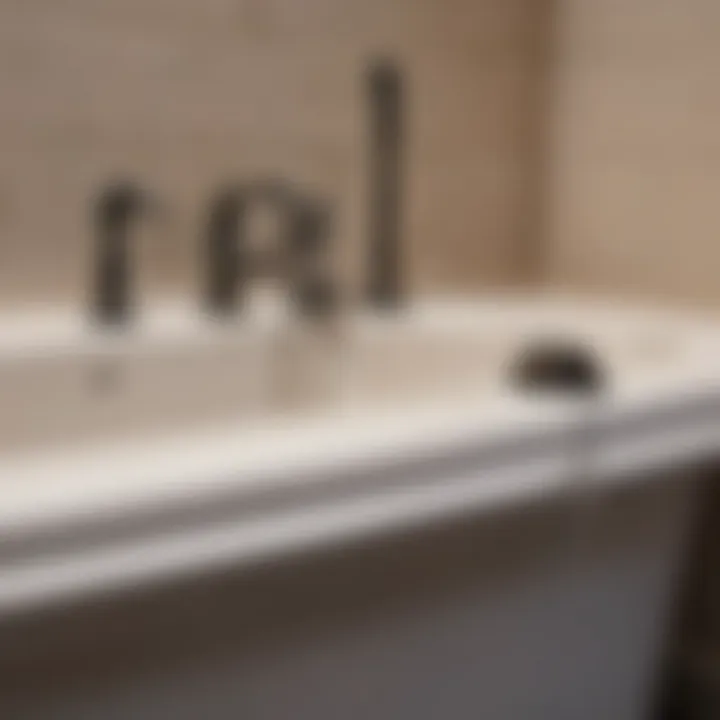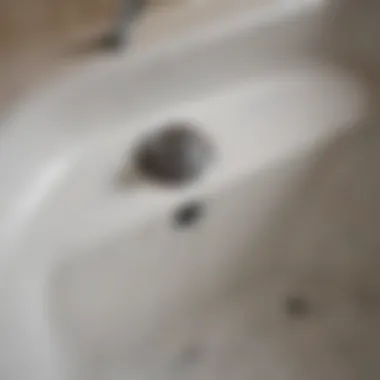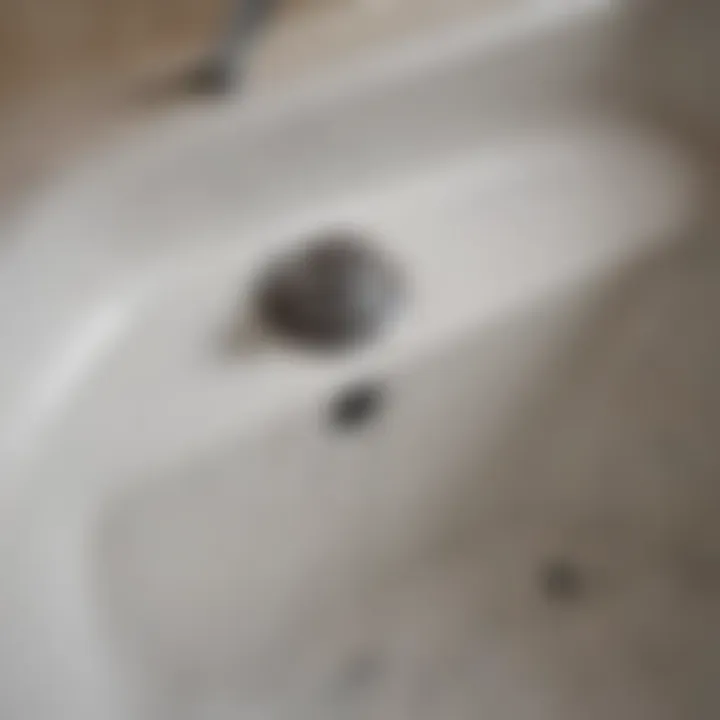Unblock Your Tub Drain: A Comprehensive Guide


Intro
Unblocking a tub drain is a common household issue that many homeowners face. Understanding how to tackle this challenge not only saves money on plumbing costs but also contributes to maintaining a well-functioning home. In this comprehensive guide, we will explore various methods for unblocking tub drains, offering insights and practical steps that anyone can take. We will cover simple DIY techniques as well as advanced solutions for persistent blockages. Furthermore, we will discuss preventive measures that can help avoid future drainage problems, making sure your home's plumbing remains efficient.
Importance of Addressing Drain Issues
Blocked tub drains can lead to a range of issues. These can include unpleasant odors, standing water, and eventual water damage if not addressed promptly. Regular maintenance and understanding how to rectify these blockages are essential for maintaining a healthy living environment. Learning the signs of trouble can lead to proactive solutions that keep your drainage systems flowing smoothly, ensuring peace of mind for homeowners.
The following sections will delve into methods of unblocking your tub drain, detailing both the tools needed and the steps involved in the process.
We invite you to explore the various approaches, from the simplest techniques to more complex strategies, that can assist in restoring your tub's drainage capabilities.
Prolusion
Unblocking a tub drain is a matter of both convenience and health. A properly functioning drain ensures that water flows efficiently, preventing potential hygiene issues. When a drain is blocked, not only does it create an unpleasant experience but it can also lead to more serious plumbing issues if not addressed in a timely manner.
Importance of a Functioning Drain
A functioning drain is essential for maintaining cleanliness in the bathroom. Slow drainage can cause water to pool, leading to a breeding ground for mold and bacteria. Regular usage creates build-up from hair, soap residue, and other debris, contributing to blockages. Ignoring a blocked drain can escalate the problem, resulting in costly repairs. Homeowners should view drain maintenance as crucial to overall home hygiene and efficiency.
Common Causes of Blocked Tub Drains
Understanding what leads to blocked tub drains can aid in prevention. Here are some common causes:
- Hair: Accumulation of hair is one of the primary reasons for blockages. It clumps together and forms a mass that hinders the water flow.
- Soap Residue: Over time, soap can react with minerals in your water, creating soap scum. This residue can build up and cause significant drainage issues.
- Foreign Objects: Items such as toys, large pieces of soap, or even personal hygiene products can lead to blockages.
- Grease and Oils: Although less common in a tub compared to a kitchen sink, shampoo and conditioner can sometimes create a greasy layer that restricts proper flow.
By understanding these elements, homeowners can implement preventive measures. In the following sections, we detail actionable steps to rectify blocked drains, ensuring a smoother and more pleasant bathing experience.
Signs Your Tub Drain is Blocked
Recognizing the signs of a blocked tub drain is essential for maintaining a smooth drainage system. Early identification can prevent more severe issues that may require costly repairs. Awareness of these signs not only saves time but also can reduce frustration in day-to-day usage. Below, we elaborate on three common indicators that point toward a potential blockage.
Slow Drainage
One of the most obvious signs that your tub drain is blocked is slow drainage. Water taking an extended time to empty from the tub often indicates a buildup of hair, soap residue, or other debris. A slow-draining tub can disrupt your bathing experience and leads to a more serious clog over time. If the water pools around your ankles while bathing, immediate attention is necessary.
Here are some possible causes of slow drainage:
- Accumulation of hair strands
- Soap scum buildup
- Foreign objects lodged in the drain
If you notice this sign, it's wise to explore some initial troubleshooting methods, such as using a plunger or pouring boiling water down the drain.
Unpleasant Odors
Another significant indicator of a blocked tub drain is the presence of unpleasant odors. Blocked drains can emit a foul smell due to stagnant water and decomposing waste material. These odors often signal trapped debris in the plumbing system. Ignoring these smells can lead to further complications, including plumbing issues and health concerns.


Unpleasant odors can result from:
- Decomposing organic matter
- Mildew formation
- Bacteria growth in stagnant water
If you encounter strange smells emanating from your drain, it is critical to act quickly. A mixture of baking soda and vinegar can sometimes help clear this buildup and eliminate odors effectively.
Gurgling Noises
Gurgling noises from the tub drain can serve as a warning sign that something is wrong. These sounds often occur when air is trapped in the plumbing system due to a blockage. When water attempts to flow past the obstruction, air bubbles can create a gurgling sound. If left untreated, this issue can worsen and lead to complete drain failure.
Possible reasons for gurgling noises include:
- Blocked vent pipes
- Debris partially obstructing the drain
- Air pressure imbalances caused by blockage
Addressing gurgling noises promptly can help avoid more significant plumbing issues later on. If you cannot resolve the issue through basic DIY methods, it may be time to consult a professional.
Regularly monitoring these signs can significantly enhance your home's drainage system. Acting swiftly when you notice these symptoms saves you from complications and costly repairs.
DIY Techniques for Unblocking Tub Drains
Unblocking a tub drain can be an essential household task. Understanding and utilizing various DIY techniques can save time and money while providing a sense of accomplishment. The focus on DIY solutions allows homeowners to tackle minor plumbing issues without the need for professional help right away. This proactive approach promotes better maintenance habits and encourages individuals to become more hands-on regarding home care.
Using Boiling Water
One of the simplest methods to clear a blocked tub drain is using boiling water. This technique is effective for clogs caused by soap scum, grease, or organic matter. To implement this method, simply bring a kettle of water to a rolling boil.
Then, carefully pour the boiling water directly into the drain. The heat can help dissolve grease and other particles stuck in the pipes. Repeat the process if necessary, allowing the water to work on the blockage. It is an accessible method that requires no special tools, making it an appealing choice. However, caution is advised as boiling water can be dangerous if not handled properly.
Plunger Method
The plunge method is also effective. A with a good-quality plunger can create a vacuum that dislodges the blockage. Begin by filling the tub with a few inches of water, which helps with suction. Position the plunger over the drain, ensuring a tight seal. Employ a firm but controlled motion, pushing and pulling the plunger. This action can help break up various clog materials. Patience is needed; it may take several attempts to resolve the issue. It is a straightforward process that should be part of every homeowner's toolkit for maintaining a functioning bathroom.
Baking Soda and Vinegar
For those seeking a more natural approach, the combination of baking soda and vinegar is an excellent option. First, pour about one cup of baking soda down the drain, followed by one cup of vinegar. The chemical reaction between the two creates bubbles that can help dislodge buildup in the pipes. Allow the mixture to sit for about 30 minutes, then flush with hot water. This eco-friendly solution is effective for light to moderate clogs, and it can also help eliminate unpleasant odors. Regular use can help maintain clearer pipes over time, promoting overall hygiene in the bathroom.
Drain Snake Usage
A drain snake can be a powerful ally in the battle against stubborn clogs. This flexible tool can reach deep into the plumbing system, either dislodging or retrieving the blockage. To use it, insert the snake into the drain until you feel resistance. Gently rotate and push to break up or grab the clog. Carefully pull the snake back out, checking for any debris that may have been removed. While this method requires a bit of practice, many find it to be a highly effective way to maintain clear drains. It is important to be gentle to avoid damaging pipes.
Wet/Dry Vacuum Approach
Employing a wet/dry vacuum can also be an effective method for unblocking a drain. Set the vacuum to liquids and create a tight seal over the drain. This method works well for removing loose debris and water. Turn on the vacuum and allow it to draw water and blockage upwards. However, caution is needed as improper usage might lead to bigger issues. It is advisable to follow the manufacturer's instructions closely, ensuring a proper understanding of the machine's capabilities.


These DIY techniques are valuable for homeowners aiming to maintain functionality in their bathroom while avoiding the costs of professional plumbing services.
Chemical Solutions for Stubborn Blockages
Chemical solutions can be vital when confronting stubborn tub drain blockages. While many homeowners opt for DIY methods first, sometimes the problem necessitates stronger intervention. Chemical drain cleaners offer a fast and efficient way to dissolve certain types of clogs that basic methods might not tackle effectively.
These solutions are particularly beneficial for those who experience persistent issues with their drains. They often work by using specialized chemicals that target and break down organic matter, soap buildup, and hair, which are common culprits behind blockages. Depending on the formulation, these cleaners can also prevent future clogs. However, using chemical solutions requires caution and knowledge of the specific products available on the market.
Overview of Drain Cleaners
Several types of drain cleaners are accessible, each designed for different situations.
- Enzymatic Cleaners: These are environmentally friendly and use natural enzymes to break down organic material. They are safe to use in various plumbing systems and great for preventive maintenance.
- Caustic Cleaners: These contain strong alkalis like sodium hydroxide or potassium hydroxide. They react with water, generating heat that can help dissolve clogs. However, they can be harmful to certain plumbing systems if misused.
- Acidic Cleaners: Products that contain sulfuric or hydrochloric acid fall into this category. They are highly effective against tough clogs but can be dangerous and damaging to pipes if not handled with care.
When selecting a drain cleaner, always read the label and ensure it is suitable for your specific plumbing conditions.
Safety Precautions
Handling chemical drain cleaners requires attention to safety. It is essential to take precautions to protect yourself and your property. Here are crucial safety measures to consider:
- Always wear rubber gloves and safety goggles to protect your skin and eyes from splashes.
- Ensure proper ventilation in the area. Open windows and doors to reduce inhalation of fumes.
- Do not mix different types of cleaners. Combining cleaners can create hazardous reactions.
- Keep drain cleaners out of reach of children and pets to avoid accidental ingestion or exposure.
"Safety first should always be the guiding principle when using powerful chemical solutions."
Taking these precautions seriously can help prevent accidents and ensure that the cleaning process is effective. Understanding how to use chemical solutions wisely enhances the maintenance of your home’s plumbing system.
When to Call a Professional
Recognizing when to engage a professional for your tub drain issues is essential. While many blockages can be handled with DIY methods, some situations are beyond simple home remedies. Knowing the signs of severe blockages will help you decide when it is necessary to seek expert intervention.
Identifying Severe Blockages
Severe blockages often exhibit distinct characteristics. If you notice that your tub drain is slow to drain even after you have tried various methods such as boiling water or baking soda and vinegar, this could indicate a more serious issue. Other warning signs include:
- Persistent gurgling noises coming from the drain.
- Standing water that does not recede even after extended periods.
- Unpleasant odors that persist despite cleaning efforts.
- Recurring clogs that return shortly after fixing them.
These signs suggest that the blockage might involve more than just simple debris. It could be a deeper issue in the plumbing, such as tree roots or significant buildup. Evaluating these factors can be crucial in preventing further damage.
Potential Damage Risks
Ignoring severe blockages can lead to significant damage to your plumbing system. Water pressure from a blockage can result in:


- Pipe Damage: Excessive pressure on pipes may cause them to crack or break, resulting in leaks.
- Water Damage: Persistent blockages can lead to overflowing water, damaging your flooring, walls, and even your foundation.
- Mold Growth: Accumulated water creates an ideal environment for mold, which poses health risks and may require costly remediation.
It is also essential to weigh the cost of professional services against the potential costs of untreated damage. In some cases, calling a plumber may save you money in the long run by addressing the problem before it worsens.
Prompt action can prevent costly repairs. If you suspect severe blockage, don’t hesitate to seek professional help.
Preventive Measures to Avoid Future Blockages
A blocked tub drain can be an inconvenience that disrupts daily activities. To mitigate this issue, adopting preventive measures greatly enhances the lifespan of your plumbing system. Being proactive means that you can enjoy a smoothly operating drain, which saves both time and money on potential repairs.
Regular Maintenance Tips
To maintain a free-flowing tub drain, regular maintenance is essential. Here are some helpful tips:
- Flush with Hot Water: Once a week, run hot water down the drain for a few minutes. This helps dissolve greases and soap residue.
- Use Drain Cleaners Carefully: Opt for enzymatic drain cleaners that are gentler on the plumbing. Avoid harsh chemicals that can worsen blockages over time.
- Inspect for Hair Buildup: Hair is a leading cause of clogs. Use a drain snake to remove hair regularly.
- Schedule Periodic Cleanings: Consider professional cleaning every few years. This can clear out buildup that routine methods may miss.
By executing these maintenance tasks, the chances of a blockage occurring will decrease significantly.
Install a Drain Cover
Installing a drain cover is a simple yet effective way to prevent debris from entering the drain. A quality cover will catch hair, small objects, and other debris before they can cause a clog. Key benefits include:
- Reduced Blockage Risk: Keeping larger particles out minimizes the risk of serious blockages.
- Easier Cleaning: Drain covers can be easily removed for cleaning, making it effortless to maintain the drain’s cleanliness.
- Variety of Options: Choose from various styles and materials to match your decor. Options include mesh, silicone, and metal.
Investing in a drain cover represents a small expense for significant long-term benefits.
Educating Household Members
Education plays a crucial role in preventing blockages. Ensure that all household members understand how their habits can affect the drain. It is essential to communicate the following points:
- Avoid Flushing Improper Items: Teach everyone what should never go down the drain. Items like cotton swabs, menstrual products, and excessive amounts of hair can cause blockages.
- Promote Responsible Use: Discuss how to use drain stoppers and maintain clean habits, like rinsing off excess hair before using the tub.
- Establish a Routine Checking System: Encourage family members to regularly check the drain and report any issues, such as slow drainage.
Educating your household ensures that everyone contributes to maintaining the plumbing system and avoids unnecessary hassles down the line.
Remember: An ounce of prevention is worth a pound of cure.
End
Recap of Key Takeaways
- Recognition of Blockage Signs: Identify early signs such as slow drainage, unpleasant odors, and gurgling noises. Prompt action can prevent more severe blockages.
- DIY Solutions: Basic methods like using boiling water, plungers, and household items like baking soda and vinegar can often solve minor issues effectively.
- Chemical Cleaners: For stubborn blockages, understanding the role of chemical drain cleaners and following safety precautions is essential.
- Professional Assistance: In cases of severe blockages or potential damage risk, knowing when to seek help is vital. Professional plumbers possess the experience to handle intricate problems.
- Preventive Maintenance: Regular checks and utilizing drain covers can significantly reduce the risk of future blockages. Education of all household members also plays a critical role in ongoing maintenance efforts.
Importance of Timely Intervention
Timely intervention is not just important; it is essential. Ignoring early signs of a blocked tub drain may lead to more complicated problems and higher repair costs. The longer a blockage remains untreated, the greater the potential for water damage, mold growth, and unhealthy odors.
Homeowners should stay vigilant about the performance of their drains. Regular maintenance and immediate action when issues arise can save time, money, and unnecessary stress. By understanding the importance of prompt repair and employing preventive measures, householders can enjoy a smooth-flowing drain system.
Remember: A proactive approach can often save a simple issue from turning into a full-blown plumbing crisis.







